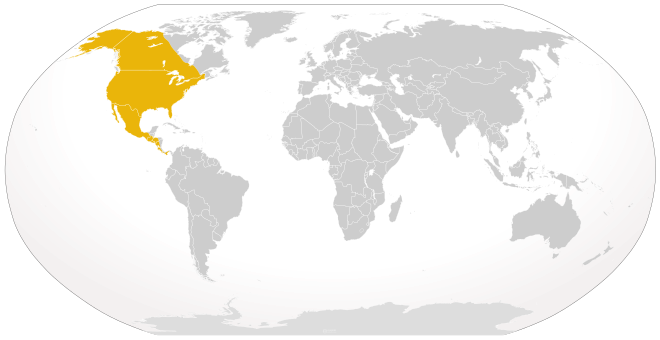User:Cinndeee/sandbox
Animal in the Arizona Upland
[edit | edit source]Coyote
[edit | edit source]The Coyote (Canis latrans) is a canine that lives in North America, roaming the plains, deserts, mountains, and forests. Coyotes are primarily carnivorous, they prey on rabbits, birds, deer, reptiles, fish, invertebrates, and amphibians. Occasionally, they eat fruits and vegetables. Humans are considered to be the biggest threat to coyotes, followed by gray wolves and cougars. The average male weighs 8 to 20 kg and the average females weigh 7 to 18 kg. The hair of this animal varies depending on where they are geographically located. The predominant color of their hair is fulvous or grey and red.
Habitat
[edit | edit source]Coyotes live in North America where they roam the mountains, plains, forests, and deserts of the United States, Mexico, and Canada. Although coyotes are known to easily adapt to different habitats, they typically prefer to live in open areas like deserts and prairies. As humans take more and more land, coyotes can also be found living around large cities, where they are beginning to adapt.
Diet
[edit | edit source]Although they are thought to be only meat eaters, coyotes are actually omnivores--eating vegetation and meat. Generally, coyotes are scavengers and are predators of small prey, but occasionally, they shift to large prey. Coyotes will prey on birds, rabbits, reptiles, fish, deer, invertebrates, and amphibians. Some fruits and grains they feed on include, berries, apples, peaches, watermelon, carrots, beans, wheat, and corn. Most of the time coyotes hunt alone, but when hunting for large prey such as deer, they will hunt in packs. For those that live in large cities, coyotes will normally kill pets and livestock, eat pet food, or garbage.
Life Span
[edit | edit source]The average lifespan of a coyote is six to eight years in the wild, while those in captivity can live twice as long ranging from thirteen to fifteen years. They are affected by a variety of diseases and parasites which include, intestinal worms, heartworms, fleas, and ticks. They may also be affected by the parvovirus, canine distemper, and mange. However, humans are considered to be the greatest threat to humans. In rural areas, the major cause of death is due to trapping and hunting, while in urban areas, the cause of death is primarily automobiles. There has been an average of automobile collisions from 40 to 70 percent each year.
- REDIRECT [[1]]
Importance
[edit | edit source]Coyotes play an important ecological role in the environment by helping maintain healthy ecosystems and boosting biodiveristy. As they are the top carnivores in some ecosystems, they regulate mesocarnivore populations, which include, foxes, skunks, opossums, and raccoons.
Facts
[edit | edit source]- Coyotes can run up to 40 miles an hour.
- Coyote pups are born blind.
- Coyotes are nocturnal.
- Coyotes are monogamous and only have one mate for the rest of their life.
- Coyotes have few natural predaters. They include mountain lions, wolves, and bears.
Plant in the Arizona Upland
[edit | edit source]Fish-hook Barrel Cactus
[edit | edit source]The Fish-hook Barrel Cactus (Ferocactus wisilizeni) also called the Arizona barrel cactus is a species of flowering plant in the cactus family Cactaceae. The fish-hook cactus is characterized by its two-foot diameter, long hooked spines, and barrel body shape. On the cactus, yellow/red flowers and yellow fruit grow at the superior surface. This species of barrel cactus can be found in Northern Sonoran, Mexico and in South-Central Arizona. The fish-hook barrel cactus has a life span of about 50-100 years. The conservation status of this plant is vulnerable and the population is decreasing.
Habitat
[edit | edit source]The fishhook barrel cactus is found throughout South-Central Arizona and Northern Sonoran, Mexico. It grows primarily in grasslands and desert shrubs, but it can also grow in deserts often on rocky, gritty, or sandy soils on the hillsides from 300 to 1,600 m elevation. The fishhook barrel cactus does not need much water to survive as it can tolerate dry soil moisture, but it does require lots of sunlight. This heat-tolerant plant contains "fishhook" spines along the cactus body to protect it from herbivores. At the top of the cactus, the plant grows yellow/red flowers and yellow/red fruit.
Importance
[edit | edit source]The fishhook barrel cactus is important not only because it enhances the beauty of the desert landscape, but it provides fruit to animals and birds. Javelina, birds, and deer eat the fruit; the birds especially like the seeds. The fruit can also be used to make candies and jellies.
Facts
[edit | edit source]- The fishhook barrel cactus is often called the "Compass Barrel" because most of the larger plants lean towards the southwest.
- The cactus does contain water, but if it is ingested it can cause diarrhea due to the oxalic acid it contains.
- The lifespan is 50-100 years.
- It commonly grows 2-4 feet tall but can grow up to 6-10 feet tall in some cases.


